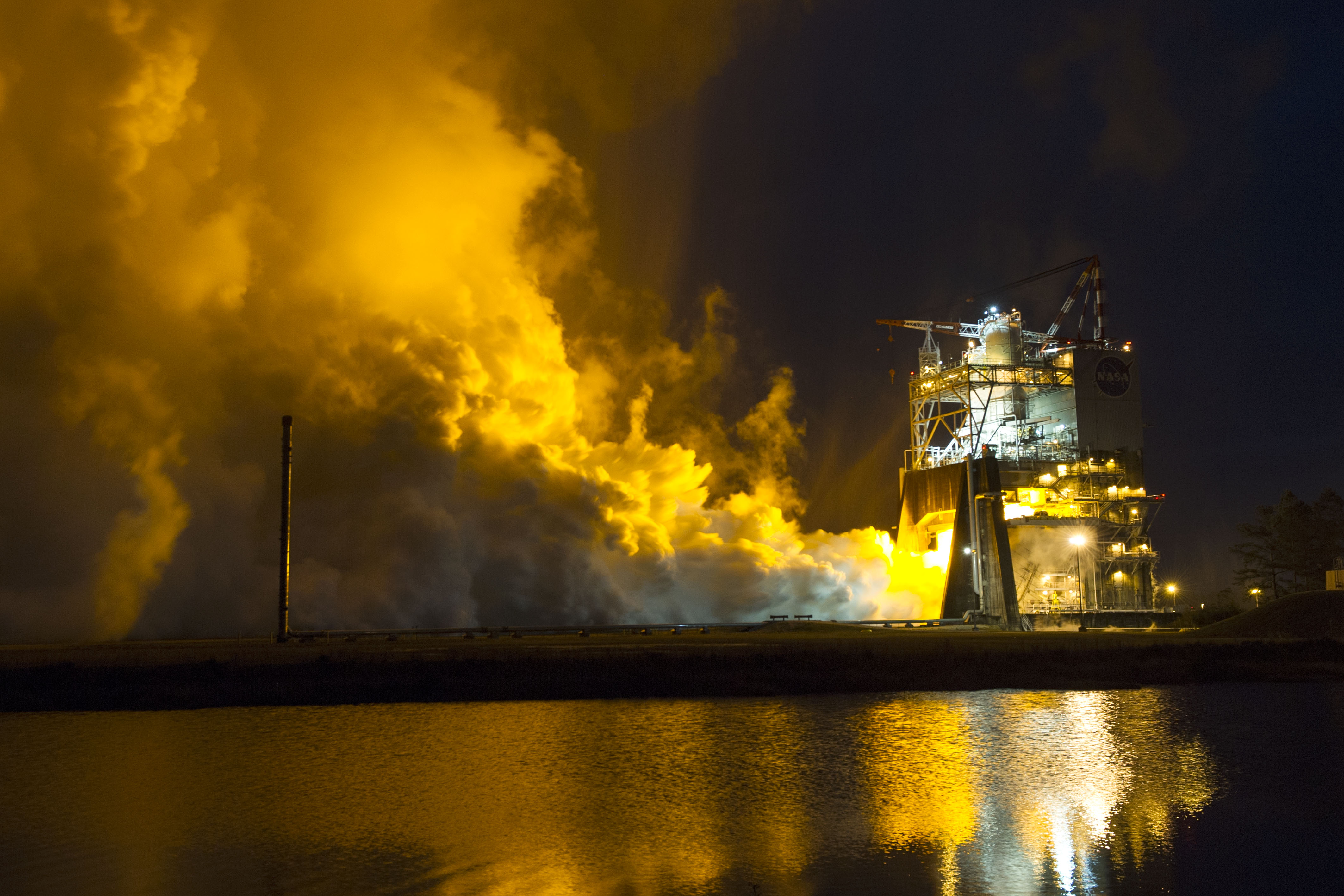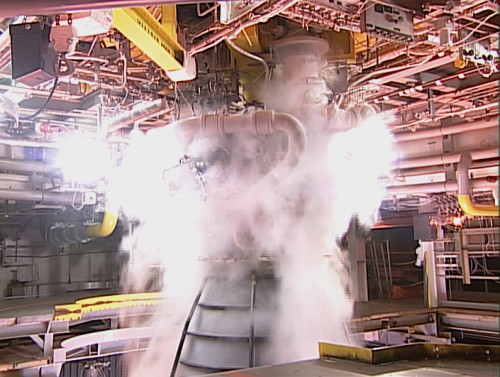
The new year has kicked off nicely for NASA thus far, not just because of a successful fifth SpaceX Dragon resupply launch to the International Space Station (ISS), but also because the agency’s Stennis Space Center near Bay St. Louis, Miss., has ushered in a new era with the first static test fire of a development engine for the Space Launch System (SLS), NASA’s massive rocket which will launch astronauts on missions of exploration farther into space than any humans have ever been, starting next decade.
The first reusable rocket engine in history, the RS-25, proved its worth during the 30-year space shuttle program, and those engines will again be employed to power the mammoth 321-foot-tall SLS on its initial ascent toward space, but with several modifications made to the engines to meet the giant rocket’s thrust requirements.
Locked down on the A1 test stand, Engine #0525 roared to life for 500 seconds, providing NASA engineers with critical data on the engine’s new state-of-the-art controller unit—the “brain” of the engine, which allows communication between the vehicle and the engine itself, relaying commands to the engine and transmitting data back to the vehicle. Higher inlet pressure conditions, thanks to the engines upgrades, will also be evaluated.

The new controller also provides closed-loop management of the engine by regulating the thrust and fuel mixture ratio while monitoring the engine’s health and status, thanks to updated hardware and software configured to operate with the new SLS avionics architecture.
Engine 0525 is just a development engine, but the information it provides in testing will help perfect the engines that will fly on the SLS, starting with the Exploration Mission-1 (EM-1) in late 2018.
“We’ve made modifications to the RS-25 to meet SLS specifications and will analyze and test a variety of conditions during the hot fire series,” said Steve Wofford, manager of the SLS Liquid Engines Office at NASA’s Marshall Space Flight Center in Huntsville, Ala., where the SLS Program is managed. “The engines for SLS will encounter colder liquid oxygen temperatures than shuttle; greater inlet pressure due to the taller core stage liquid oxygen tank and higher vehicle acceleration; and more nozzle heating due to the four-engine configuration and their position in-plane with the SLS booster exhaust nozzles.”
For shuttle flights the engines pushed 491,000 pounds vacuum thrust during launch—each—and shuttle required three to fly, but for SLS the power level was increased to 512,000 pounds vacuum thrust per engine, and the SLS will require four to help launch the massive skyscraper-size rocket with a 70-metric-ton (77-ton) lift capacity that the initial SLS configuration promises.
“During the 30-year run of the Space Shuttle Program, the RS-25 achieved very high demonstrated reliability,” said Garry Lyles, chief engineer for the Space Launch System Program Office at Marshall Space Flight Center. “And during 135 missions and numerous related engine tests, it accumulated over 1 million seconds — or almost 280 hours — of hot-fire experience. With that kind of reliability, we knew it would be the best engine to power SLS.”
VIDEO: Watch as NASA’s RS-25 SLS development engine #0525 ignites for the first SLS engine test fire.
To put the power of the Aerojet Rocketdyne-built RS-25 engines into perspective, consider this:
- The fuel turbine on the RS-25’s high-pressure fuel turbopump is so powerful that if it were spinning an electrical generator instead of a pump, it could power 11 locomotives; 1,315 Toyota Prius cars; 1,231,519 iPads; lighting for 430 Major League baseball stadiums; or 9,844 miles of residential street lights—all the street lights in Chicago, Los Angeles, or New York City.
- Pressure within the RS-25 is equivalent to the pressure a submarine experiences three miles beneath the ocean.
- The four RS-25 engines on the SLS launch vehicle gobble propellant at the rate of 1,500 gallons per second. That’s enough to drain an average family-sized swimming pool in 60 seconds.
Engine 0525 is tasked with carrying out eight hot-fire tests, the next of which is expected to occur in April after upgrades are completed on the high pressure industrial water system, which provides cool water for the A1 test stand during a hot-fire engine run. Over the course of its eight tests, the engine will fire for a grand total of 3,500 seconds, followed by another 10 test fires with another development engine, which will be put through its paces for a grand total of 4,500 seconds. The second test series will include the first test of new flight controllers as well, known as green running.
“This first hot-fire test of the RS-25 engine represents a significant effort on behalf of Stennis Space Center’s A-1 test team,” said Ronald Rigney, RS-25 project manager at Stennis. “Our technicians and engineers have been working diligently to design, modify and activate an extremely complex and capable facility in support of RS-25 engine testing.”
Want to keep up-to-date with all things space? Be sure to “Like” AmericaSpace on Facebook and follow us on Twitter: @AmericaSpace
Missions » SLS » Missions » SLS » EM-1 »


